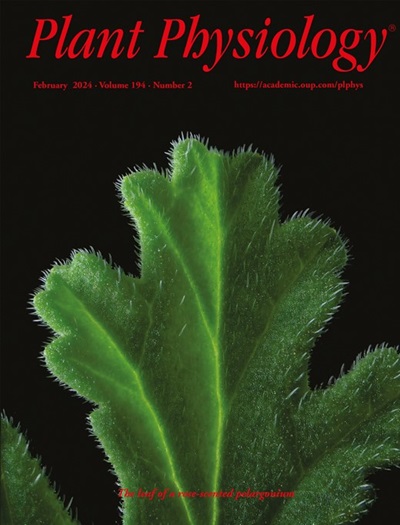许多转录因子家族在植物中具有进化上保守的结合基序
IF 6.5
1区 生物学
Q1 PLANT SCIENCES
引用次数: 0
摘要
转录因子控制基因在发育过程中的表达,并响应广泛的内部和外部刺激。它们通过直接结合DNA中的顺式调控元件来调节启动子的活性。被子植物拟南芥(Arabidopsis thaliana)含有超过1500个带注释的转录因子,每个转录因子都含有一个dna结合域,用于定义转录因子家族。通过分析拟南芥转录因子的686个结合基序和335个结合位点,以及来自其他植物的92个转录因子的结合基序,我们确定了74个保守基序,涵盖了植物中50个科。在21个转录因子家族中,我们发现所有被分析的成员都有一个核心基序,并且在2%到72%之间有重叠的结合位点。五个家族显示沿系统发育进化枝的基序保护。包括C2H2锌指家族在内的5个家族在植物中显示出高度的基序多样性,这表明基于所识别的基序,可能存在重复转录因子的新功能化。我们利用扩增DNA亲和纯化测序技术,确定了Marchantia (Marchantia polymorpha) 11个家族的17个转录因子的结合基序,以检验保守基序是否至少从4.5亿年前就保持了保守。我们检测到与被子植物数据预测的几乎相同的结合基序。我们的研究结果表明,在一个转录因子家族和物种中存在大量重叠结合位点,并且结合基序的高度保护至少持续了4.5亿年,这表明顺式调控元件的进化潜力更大,而不是反式调控元件。本文章由计算机程序翻译,如有差异,请以英文原文为准。
Many transcription factor families have evolutionarily conserved binding motifs in plants
Transcription factors control gene expression during development and in response to a broad range of internal and external stimuli. They regulate promoter activity by directly binding cis-regulatory elements in DNA. The angiosperm Arabidopsis (Arabidopsis thaliana) contains more than 1,500 annotated transcription factors, each containing a DNA-binding domain that is used to define transcription factor families. Analyzing the binding motifs of 686 and the binding sites of 335 Arabidopsis transcription factors, as well as motifs of 92 transcription factors from other plants, we identified a constrained vocabulary of 74 conserved motifs spanning 50 families in plants. Among 21 transcription factor families, we found one core motif for all analyzed members and between 2% and 72% overlapping binding sites. Five families show conservation of the motif along phylogenetic clades. Five families, including the C2H2 zinc finger family, show high diversity among motifs in plants, suggesting potential for the neofunctionalization of duplicated transcription factors based on the motif recognized. We tested whether conserved motifs remained conserved since at least 450 million years ago by determining the binding motifs of 17 transcription factors from 11 families in Marchantia (Marchantia polymorpha) using amplified DNA affinity purification sequencing. We detected nearly identical binding motifs as predicted from the angiosperm data. Our findings show a large repertoire of overlapping binding sites within a transcription factor family and species and a high degree of binding motif conservation for at least 450 million years, indicating more potential for evolution in cis- rather than trans-regulatory elements.
求助全文
通过发布文献求助,成功后即可免费获取论文全文。
去求助
来源期刊

Plant Physiology
生物-植物科学
CiteScore
12.20
自引率
5.40%
发文量
535
审稿时长
2.3 months
期刊介绍:
Plant Physiology® is a distinguished and highly respected journal with a rich history dating back to its establishment in 1926. It stands as a leading international publication in the field of plant biology, covering a comprehensive range of topics from the molecular and structural aspects of plant life to systems biology and ecophysiology. Recognized as the most highly cited journal in plant sciences, Plant Physiology® is a testament to its commitment to excellence and the dissemination of groundbreaking research.
As the official publication of the American Society of Plant Biologists, Plant Physiology® upholds rigorous peer-review standards, ensuring that the scientific community receives the highest quality research. The journal releases 12 issues annually, providing a steady stream of new findings and insights to its readership.
 求助内容:
求助内容: 应助结果提醒方式:
应助结果提醒方式:


